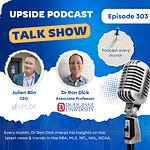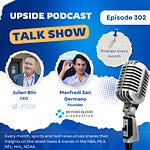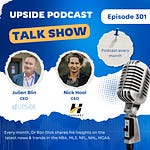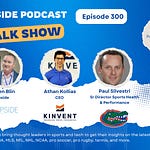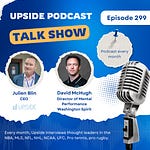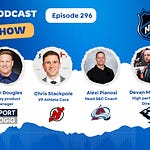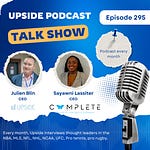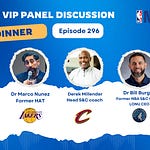This week we have the honor to interview again a group of sports performance experts focusing on rehab/return to play.
Jason Han, Head of Rehabilitation / Team Physical Therapist., LAFC (MLS team).
Dr Derek Lawrance, Assistant Athletic Trainer, U.S. Men’s Soccer National Team.
Kevin Martin, CEO of The Quick Board, which developed a visual training and rehab technology.
📝Show Notes: Through this interview, we touched on the 7 steps to return to play, the results from a Stanford study on NBA teams, and the concussion protocol used in the MLS. We also touched on the importance of mental aspect to know if an athlete is ready to return to play.
Best Quotes: Here’s some of the key discussion points and best quotes from our conversation with Kevin, Jason and Derek:
On the 7 steps to return to play:
Dr Derek Lawrance:
“It's always nice to have steps whether it is 7. 5, 3, 10 steps, so you have to have a process to it. This is all it really comes down to because everyone talks about protocols, right? And we know know that each environment is going to dictate a different type of return to play”.
“Soccer is going to be much different than basketball, much different than football. And so you're going to have different steps, and it's just a matter of defining what is it that you find most important. You can have the cognitive steps in there as well as just as much as the physical steps”.
“And again, individualizing it to the sport and the athlete is also necessary as well. And some people will probably blend a couple of steps but I think most importantly, it's just about understanding your own process and where it's going to lead you and making sure that you have the ability to check off certain boxes to ensure a safe and efficient return”.
“Because that's one of the big things that you always look at professional sports and their return to play is how fast are people getting back and that's one of the pressures that we face at this level is that we have to try to push the edge as much as you push that level as much as possible. And maybe it's finding more creative ways to get the physical demand, the cardiovascular demand to make sure that the players are ready to return to play”.
Jason Han:
“These 7 steps look similar to what we would do with athletes who have concussions in our league. But if it was a non concussion injury, then it's different. So it depends on what you're dealing with, whether it's muscle, joint injury and the severity of it all. When it comes to more of an orthopedic injury, you can mix in things sooner than later, as long as it doesn't aggravate the site of injury”.
“So you can put vigorous activity for someone with an ankle sprain, but with an arm bike, let's say starting off, or you can do a BFR it's rather vigorous in that in nature. So these seven steps. for return to play look like it's more geared towards a concussion when I look at it”.
Kevin Martin:
“Overall no matter what the number of steps are, it is critical to have guidelines based on what happened, who the individual is because you're going to have one athlete who's mentally stronger, who's going to be able to get through something if it's a muscular or musculoskeletal injury, or a concussion”.
“And then you need to know what their environment is, and the sport that they're returning to. And so I think it has to be an adaptive approach. In terms of what your steps are, you have to have a plan that's going to dictate whether the return is successful or not”.
On the protocol that MLS have to follow when a concussion event accur:
Dr Derek Lawrance:
“In the MLS we use a protocol based on a solution from Headcheck Heath. When I was at the SJ Earthquakes (MLS), we had to follow the MLS protocol, especially with concussions (..) So we want to make sure that we are as conservative as possible in a sense, but conservative yet aggressive as long as the players complete the steps in a good way”.
“If you really look into it, they recommend 24 hours in between each steps, and there are 8 steps to this protocol, if I'm not mistaken, unless they change it since I've been out, but there's recommendation of 24 hours between. So you can blend a couple of the steps together if that person is feeling very well, because there's some times where if they become asymptomatic within 24 hours, they go through the 1st step, which is light exercise. 15 minutes. That's no problem. So then you can accelerate a little bit”.
“Typically there are a couple of steps that are combined because one of the fewer steps at the end is heading the ball from 6 yards away. You can combine that with a non contact training. So you're going to do steps 5 and 6 together (..) There is doctor/physician clearance every single step and they're reporting symptoms every single step”.
“So there are the checks and balances. Headcheck Health is the solution we use, so they have to report it. So there is obviously a documentation. For each step as well, but most of it is, it's a guideline, you do have to do it from what they say, in terms of making sure you check every step”.
On the importance of mental aspect to know if an athlete is ready to return to play:
Jason Han:
“I would say it's not just at the return to play state, it starts day one, whether it's a long term injury or even a short term injury and just getting to know your athlete that much better and understanding is this the 1st time that they have had a major injury? Is this the 1st time they're having a muscle injury? Are they young? Have they been through 10 of these before? Everyone's a little bit different on how you target them in the rehab process and as you talk about their progression but I think that's the first thing”.
“And if you fast forward to the part where they're going back into partial team training, it's in your RTTs leading up to that, it's creating situations that can mimic that as much as possible. But nothing is going to replace what it feels like to have 20 plus guys around you going at full speed. But so in the rehab process, it's about getting them comfortable designing drills that can mimic that as much as possible”.
“And then as they return to the team, it's having that relationship with him, having the relationship with the technical staff, seeing where they're at.”
“And they may tell you that they're fine, but if you know them well enough, and you've seen them when they're relatively healthy and you watch. It's just holding them accountable to telling you the truth afterwards. They're always going to push because they want to play, but if you can tell inside that things are just not right, and you get it out of them, and that's a time not to stop the process, but to reevaluate and talk to them about the pros and cons”.
“And let's say they're scared that they're going to get hurt more when they return to play. And then it's like, based on what we've seen so far, you've checked these boxes, this, this, this, and that the chances of you getting hurt, I'm not saying there's zero chance, but the chances are relatively low, especially if we're doing this, how do you feel about this? So, I think that relationship is super important instead of just forcing them out there without any guidelines”.
On whether or not MLS or NBA teams have a sports psychologist on staff and the fact that oftentimes the performance / medical staff (athletic trainer, PT..) have to take on that task:
Jason Han:
“I don't know about the NBA. In the MLS, it's not common to have a sports psychologist. At LAFC, we have a mental performance coach, but I guess every club is different on how they utilize it. I think at the end of the day, you have to develop trust, and then oftentimes it's the physios and the athletic trainers and the massage therapist, the ones that put their hands on them, because that's your time to talk”.
“Let's say they're on the table for X amount of minutes, you're talking. But if you're going with a mental therapist, you're going there to talk. And a lot of these guys may not be ready or open to it, but it naturally happens when they're on the table with us. Because we spend so much time together, so it depends on the club and their model and what they feel is important”.
Dr Derek Lawrance:
“I agree with Jason. What we do is low level psychologist for sure. I will say a lot of times in the MLS, it's still unfortunately comes down to money to have a sports psychologist or not. And you have to find a way to afford someone who's going to have this role that isn't as used as much as we may believe”.
Kevin Martin:
“It's a natural environment with you guys in the training room. It's the role that sports, physical therapist takes on or the athletic trainer at the school, takes on where they are handling part of the rehab and, and helping them through that”.
“And at the same time, I think, for instance, people like Kevin Wilk, and I've attended quite a few of his courses and in his progressions, he wears athletes out to where they're going to be so confident in what they can do in such as way that there's no doubt left”.
You may also like:
🔥 Upside Chat: Dave Hancock, CEO, Apollo (Leading Athlete Management Systems (AMS) vendor)
🔥 Upside Chat: Dr Andy Barr, Consultant, Brooklyn Nets (NBA) & Quantum Performance Founder
🔥 Upside Chat: Ismael Fernandez, ThermoHuman CEO
🔥Upside: AMS Ecosystem Analysis: Key Trends, Vendors and Recommendations to Teams
💦Upside Analysis: The sweat and heat sensing market (Key Trends, Vendors)




